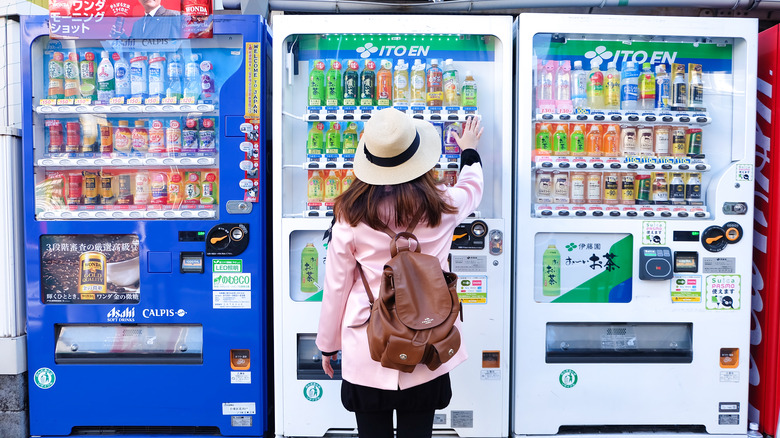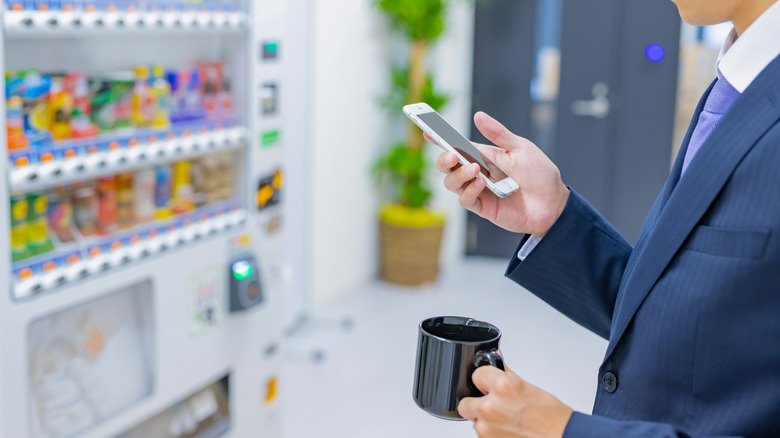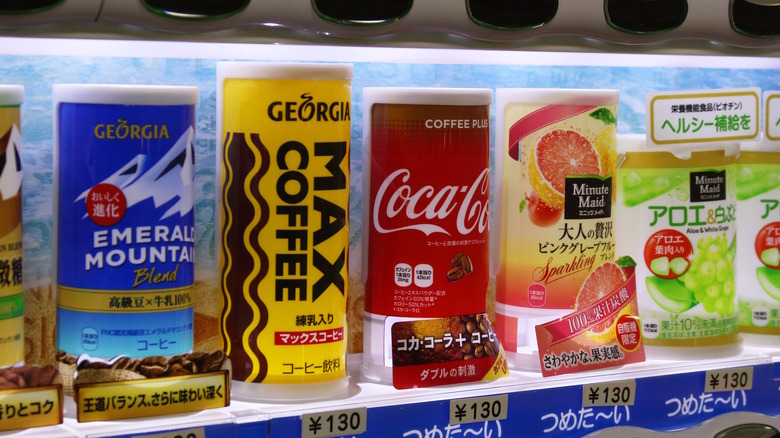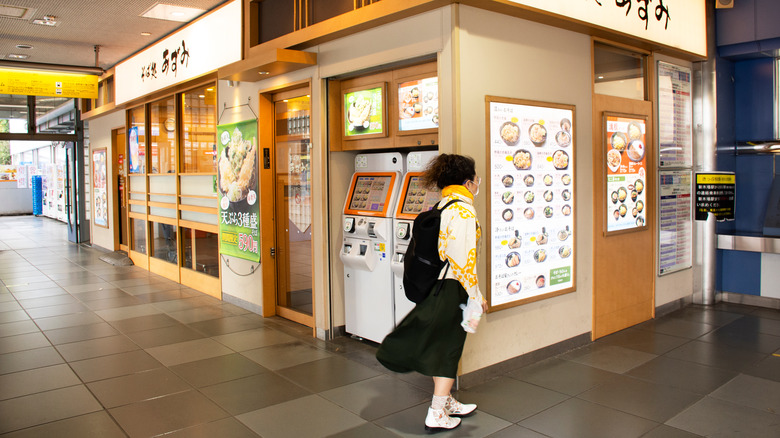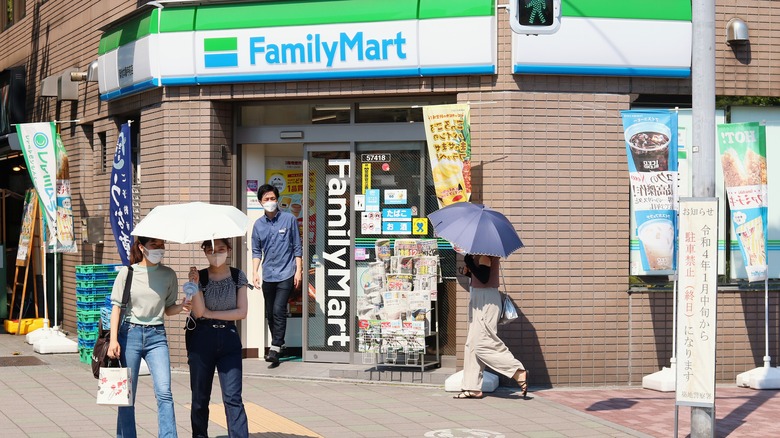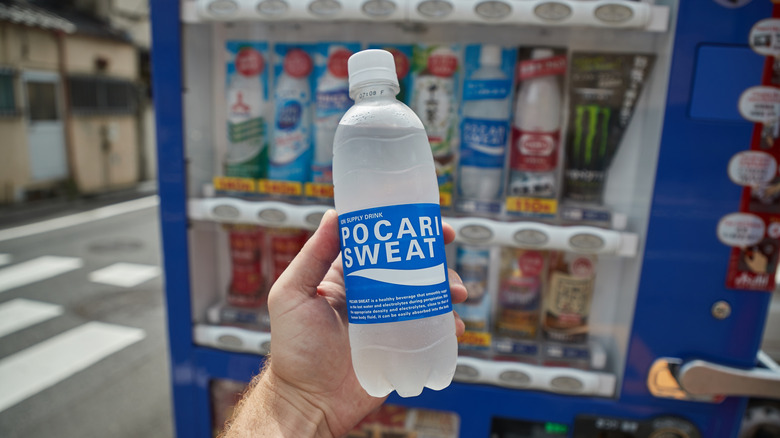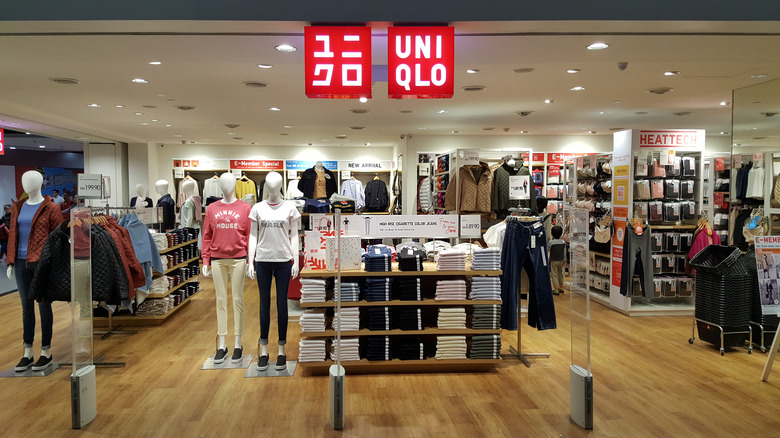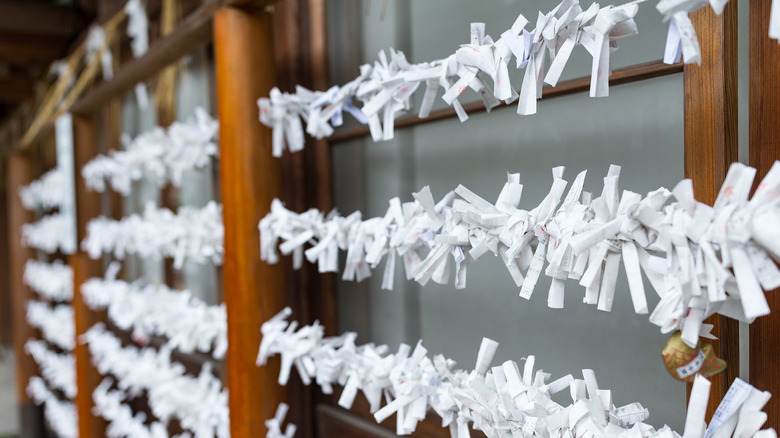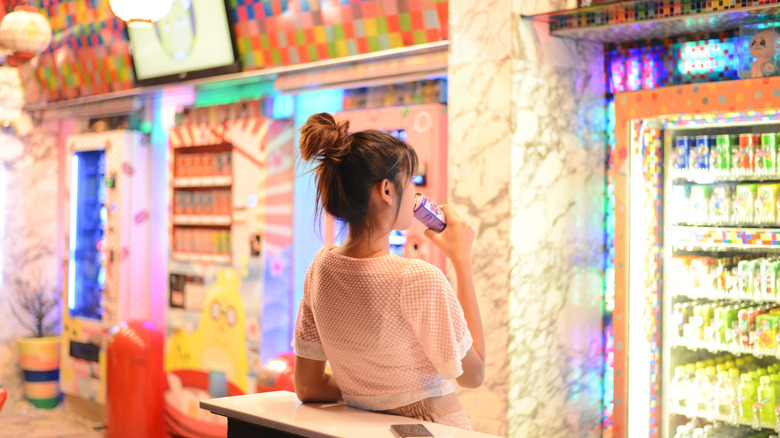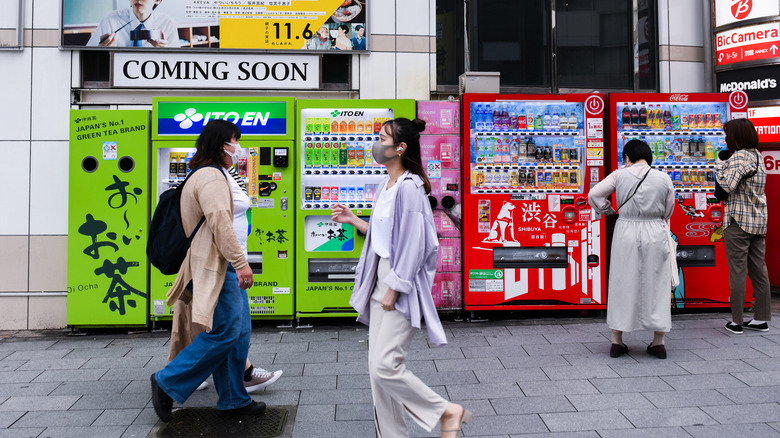Everything You Need To Know About Japanese Vending Machines
Visiting Japan means having your mind blown every few minutes. From the temples to the neon signs, it's a fascinating culture, and this includes their vending machines. It turns out that jidōhanbaiki (the Japanese word for vending machines) is quite a phenomenon in this corner of the world. Statistics say there is one vending machine per every 23 Japanese citizens — more than 5 million, according to Business Insider — and their annual sales are more than $60 billion. You'll find them everywhere, from train stations and busy city corners to temples and small mountain towns.
The first modern vending machines can be traced back to the '20s, when candy machines began to grace the sidewalks of urban landscapes and later offered fruit juice by the '50s. Half a century later, in the '70s, these mechanical marvels truly stepped up their game and started selling cold and warm drinks (we'll get into that novelty in a minute), courtesy of the Pokka company.
They're made for a high-speed culture
It's easy to associate Japanese culture with technology, automation, and robots. Thus in a society that values convenience, vending machines have become vital to the daily user.
Interestingly, Japanese culture is also highly ceremonial, especially when it comes to service. Payment at a shop or restaurant is quite the ceremony, so it might seem surprising that contactless purchases are so popular. However, machines allow people to skip the courtesies without feeling bad about it. Got some coins or your IC card in your pocket? You're only seconds away from a snack or a brand new T-shirt; no talking required.
Safety is an important factor regarding the ubiquity of vending machines in this island country. Low crime rates allow vending machine operators to rest easy, knowing their machines won't be vandalized or broken.
Finally, hard work is another top priority among the Japanese, especially those who live in large busy cities. In those cases, finding a ready-to-eat lunch in seconds at your trusty corner machine is a lifesaver.
The variety of drinks is astounding
Thousands — or millions, probably — of machines are stocked with the expected soda and water bottles. Still, you're also surely going to find a variety of Japanese staples, like green tea and canned coffee. The best part? Many of these are sold at a perfectly warm temperature! In fact, the success of vending machines and canned coffee is linked. Japanese-born Ueshima Coffee Company (UCC) launched canned coffee in 1969, an ideal product for a fast-paced society needing a quick, on-the-go jolt of caffeine. According to The Coffee Maker, when Pokka introduced the hot and cold drink vending machine, it helped heat up the canned coffee business (pun intended).
On the other hand, if you're searching for something to cool you off in the sweltering summer heat, you need to look for one of the most peculiar machines: The Slushie Coke dispenser, which sells a regular-looking bottle of Coca-Cola. Once you open it, you take a sip and pour it into a cup, and it starts to thicken and get icier until it becomes a slushie.
In the mood for sake? Head to the Echigo Yuzawa Station (in the Niigata Prefecture), home to the Ponshukan sake museum and store, where you'll find sake vending machines.
You can find every food item imaginable
Japan is a culinary paradise, and the joy of snacking with the help of its vending machines is part of the experience. Of course, you can find fun candy (like beloved Pocky sticks) and chips, but it's also possible to find machines that sell fresh fruit like apples and bananas, so if you're trying to eat healthy snacks, there's no excuse.
Plenty of machines offer ready-to-eat meals, such as canned soup, noodles, and curry. Ramen machines will give you a solid variety of ramen dishes to choose from, even in the middle of the night. Just check out Ramen Stock 24 outside Nakano Station in Tokyo, which doles out frozen ramen for you to prepare at home. And if you feel like you need a break from local delicacies — we're not judging — you can also find burger and pizza machines. There's even a machine in Hiroshima that will give you a pizza cutter and a bag!
In the mood for something sweet? The Japanese are pros at dessert, so keep your eyes open for machines selling cupcakes, ice cream, and cake.
Some machines get quite personal
At many train stations or city street corners, you may find machines that carry items you normally find in a convenience store or a drugstore, such as umbrellas, makeup, or flower bouquets. So if these products are already so readily available, why the need to put them in an automated box? According to Japan House, this may have to do with the high cost of real estate in Japan, which makes renting a whole store, paying for space in a store, or paying an employee so much more expensive for a retailer.
Another theory (via Japan Powered) suggests that vending machines save buyers the embarrassment of paying for personal items. This theory explains why flower bouquet machines became popular in the '90s since public romantic gestures were not usual in Japan back then. It would also explain the presence of machines selling intimate items such as condoms or underwear nowadays.
Other machines are programmed for emergencies
Aside from hard work and convenience, the Japanese also value community and are taught to think of those around them since they're kids. It makes sense then that some machines are literally programmed to help.
These machines can sense when a natural disaster has happened, such as an earthquake or a tsunami — not uncommon in Japan because of its geographic position — so their settings change and allow them to dispense free drinks and snacks to those affected. These machines also feature backup batteries or electric generators to work correctly in case of a blackout. Many are located inside schools or gyms, which are used as evacuation centers during emergencies.
During the March 2011 earthquake, Coca-Cola distributed 88,000 free drinks to affected citizens through these emergency machines. Over the past decade, these machines have increased, not just for dispensing beverages but also for displaying emergency information.
Retail juggernaut Uniqlo joined the game
It would be hard not to fall into the temptation of stepping into Uniqlo whenever you spot that all-too-familiar red and white logo during your Japanese trip (yes, even if there are more than 40 stores in the United States). But what if your packed sightseeing schedule doesn't allow it? Fear not; the retail geniuses have your back. Uniqlo vending machines are real, satisfying your fashion cravings or saving you in case of an emergency (i.e., spilled coffee or unexpected weather changes). They are smartly located at many airports and train stations.
These touch-screen machines, the very definition of fast fashion, have even crossed over to our side of the pond, stocked with classic items like T-shirts and fluffy down jackets. In 2017, the first Uniqlo To Go machines landed in four US cities (Houston, Oakland, New York, and Los Angeles) as part of the brand's American growth strategy.
You can find jidōhanbaiki in temples
As masters of mixing the old with the new and tradition with innovation, it's only natural that the Japanese would think of doling out paper fortunes via vending machines. That's right, the traditional little pieces of paper, called omikuji, usually found at Shinto shrines and Buddhist temples, also have high-tech counterparts. Traditionally, visitors make a donation and choose an omikuji from a wooden box — I once got a "medium fortune" at a Tokyo temple, promising a relatively decent future. Machines like the ones found at the Naritasan Shinoshoji Temple in Narita will swiftly give you a modern omikuji in exchange for a few coins.
Temples and shrines are also excellent spots for purchasing omamori or amulets for protection, love, health, and many other forms of luck. Amulets have also found their way into vending machines, so look no further than the vending machine at the Zenkojki Temple in Nagano Prefecture for a nice selection of good luck charms.
Vending machines are a visual delight
Like many things in Japan, a significant part of the appeal of vending machines is their aesthetic. Run-of-the-mill machines can feature everything from classic brand logos to anime characters, cute illustrations, and lots of food items with faces. No wonder they appear on so many social media posts. The hashtag #japanesevendingmachines features photos taken by fascinated visitors showing Pokémon-themed machines and dog-shaped cakes.
These local wonders have even inspired a book: Vend, Notes on the Silent World of Tokyo's Vending Machines by photographer Tim Easley. The London-based photographer first encountered Japanese vending machines in the '90s and has been fascinated with how unique and well-integrated to the landscape they are ever since.
Photographer Eiji Ohashi has also paid tribute to vending machines in his book Roadside Lights, telling a gorgeous visual story of how machines served as beacons during the long hours he spent on the road on his nighttime drives.
Vending machines might dominate the future
Historically, Japan has been a cash-based culture, so most traditional vending machines are coin-operated. However, newer versions found in large cities are equipped with touch-screen technology and accept most forms of payment, like credit cards or IC Cards (prepaid cards used for public transportation). This allows for a much better product display, and the bright LED screens can be used for advertisement. Some screens even change according to the seasons and may show cherry blossoms or snowy landscapes.
The most cutting-edge machines, like those made by Acure, feature facial recognition technologies that suggest items based on the customer's age and gender after analyzing them through a camera placed in the machine. They also allow customers to purchase products using an app or to buy their friends drinks using said app. Their machines are also tailored for specific points of purchase, like schools or art museums; some even boast designs by artist Mio Hashimoto.
